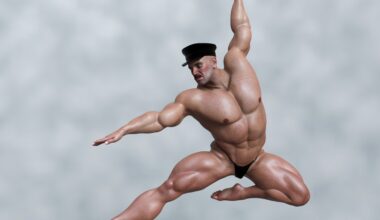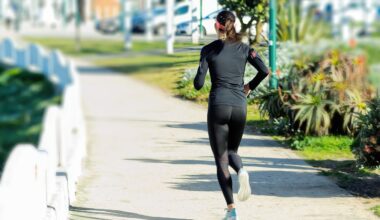How Volunteering Can Increase Your Drive to Stay Physically Active
Volunteering offers older adults a unique opportunity to enhance their drive for physical activity, fulfilling social and emotional needs. As individuals age, maintaining a physically active lifestyle can be challenging. Engaging in volunteer work not only allows them to contribute to their community, but it also helps to keep them active. Physical activities involved in volunteering can range from organizing community events to leading fitness classes. The very act of volunteering provides a sense of purpose and accomplishment. Furthermore, this engagement also fosters social connections. New friendships and networks formed through volunteering create a supportive atmosphere that motivates individuals. This support plays a crucial role in encouraging consistent participation in physical activities. Volunteering empowers older adults by enhancing self-esteem and confidence. Both are integral in maintaining a consistent fitness regimen. Previous studies have shown that older volunteers display increased physical health and emotional well-being. Therefore, volunteer programs tailored toward seniors can serve as effective platforms to encourage fitness and activity levels. The key lies in finding a volunteer opportunity that aligns with personal interests, ensuring that older adults remain engaged and motivated.
Being part of a community-focused project can stimulate older adults to stay physically active. When individuals recognize that their efforts matter and contribute to a greater cause, they are more likely to remain committed to their fitness routines. The motivation derived from volunteering is particularly beneficial in later life. Taking part in community initiatives helps to establish routines that incorporate physical activities. For instance, volunteering at local events might require physical tasks like lifting, walking, or standing for extended periods. These activities contribute not just to the community but to the volunteer’s overall fitness. Moreover, working alongside younger volunteers helps to inspire older adults to keep pace and remain active. This intergenerational interaction can spark enthusiasm for various fitness-related activities. Volunteers may find joy in sharing their expertise and experiences with younger generations, creating an atmosphere of mutual inspiration. By recognizing their value, older adults often experience renewed motivation to prioritize their health. Additionally, volunteering can be a fun and fulfilling experience, making exercise feel less like a chore. It embeds fitness into a social structure that promotes agility, strength, and overall health.
The Role of Social Interaction
Social interaction plays a significant role in motivating older individuals to remain active. As people age, loneliness can be a compelling issue that often leads to a sedentary lifestyle. Involvement in volunteer work combats isolation and promotes meaningful connections. These connections create an encouraging environment that encourages physical activity. When seniors volunteer, they typically work within a team, fostering friendships and support networks. Such relationships can motivate individuals to adhere to fitness routines as they encourage each other. Additionally, knowing that one has a group or community relying on them can enhance accountability. This accountability is crucial in promoting sustained physical activity. The positive feedback received from peers reinforces this behavior and strengthens bonds. It’s also beneficial to have activities designed to include movement. Programs that involve physical tasks, such as gardening or event planning, naturally incorporate exercise. As volunteers carry out these tasks, they engage their bodies in healthy physical movement while enjoying the camaraderie of their peers. Ultimately, this social aspect of volunteering solidifies a commitment to ongoing fitness, thus improving overall well-being.
Furthermore, volunteering opportunities can provide structured environments where older adults make physical activity a part of their life. Whether it’s walking dogs at a shelter or volunteering at special events, engaging in these activities builds an enjoyable routine. Research indicates that creating schedules tied to events can increase adherence to exercise. When older adults link their physical activity to volunteering obligations, they prioritize health alongside service. This dual focus can lead to improved physical and mental health outcomes. Over time, completing physical tasks enhances stamina and strength, contributing positively to their fitness levels. Volunteering can also evoke feelings of satisfaction stemming from tangible results. Seeing positive changes in others can lead to enhanced motivation; hence, reinforcing their desire for personal fitness. Picking causes that resonate with personal passions can enhance enthusiasm. For many seniors, engaging in something they care about further strengthens their resolve to stay active and healthy. Lastly, integrating fitness in a setting that emphasizes community helps transform the perception of exercise from a solitary endeavor into a rewarding, shared experience that promotes sustained engagement.
Setting Goals through Volunteering
Volunteering can also help older adults set and achieve personal fitness goals. Many times, individuals do not see a clear path or framework for achieving their health aims. Volunteering provides a structure within which goals can be established and tracked. Whether it be specific activity sessions, weekly meetings, or project timelines, these frameworks motivate seniors. They begin to view their volunteering as part of a larger fitness journey, transforming their lifestyle into one that includes regular exercise. Goal setting becomes easier when joined with community work, as it creates milestones to reach through volunteering. This can include meeting new people, assisting in an event, or trying new physical activities. Celebrating these achievements reinforces positive behaviors. For instance, a senior who helps organize a local fun run might prioritize training for their own fitness. Capturing these special moments can serve as points of reflection, demonstrating growth. When individuals reflect on their journey, they recognize how far they have come. Such appreciation aids mental wellness and fosters self-efficacy. Ultimately, making fitness goals explicit within the context of volunteering reinforces commitment.
Another benefit of volunteering is the potential for skills acquisition and development, both of which can indirectly foster an active lifestyle. Participating in various community-driven activities allows seniors to learn about health and fitness through experience. Whether it’s acquiring training on physical skills or even nutrition education, knowledge gained enhances their awareness of fitness. Volunteering roles that Encourage movement can help individuals adapt to engaging physically while making a difference in their communities. Furthermore, the knowledge gained can be shared with peers, creating an environment where exercise becomes part of the conversation. This sharing furthers individual motivation and cultivates a supportive culture around fitness. Volunteers often inspire one another, sharing advice and success stories that empower others to act. The exchange of ideas also opens up potential new activities, such as group walks or classes. Learning about other perspectives reflects on one’s fitness journey. Exploring different ways to stay active helps maintain excitement and reduces the risk of burnout. Embracing such experiences ensures ongoing involvement as well as sustained motivation to pursue fitness goals generously.
Conclusion
In summation, volunteering provides older adults with numerous incentives to increase their physical activity. The integral components of social interaction, goal setting, and skill acquisition cultivate an environment that encourages consistent engagement in fitness. By serving their communities, older adults experience a renewed sense of purpose that inspires them to take care of their health and wellness. The benefits of volunteering extend beyond individual empowerment by fostering social connections and mutual motivation amongst peers. By creating networks of support, older individuals sustain their commitment to physical activity. Volunteering encourages regular movement, transforming exercise into a rewarding part of their lifestyle. Programs tailored to seniors can combine personal interests with community service to maximize both enjoyment and fitness benefits. These experiences not only contribute to individual wellbeing but also enrich the community’s fabric. As we recognize the importance of remaining active in later years, volunteering presents a viable path to achieving these goals. It embodies an invaluable way for seniors to integrate altruism with fitness. Involving oneself in volunteer work positions seniors as active participants in both their lives and their communities.


